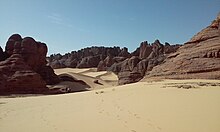Algerian Desert
| Algerian Desert الصحراء الجزائرية | |
|---|---|
 El Gour in El Bayadh Province | |
 Map of the Algerian arid desert | |
| Geography | |
| Country | |
| Climate type | Arid desert |

The Algerian Desert (Arabic: الصحراء الجزائرية, romanized: al-Saḥrā' al-Jazā'iriyah) is a desert located in central North Africa within Algeria, constituting part of the Sahara. The desert covers more than 90% of Algeria's total area.[1] In 2018, it was home to a population of 3,600,000 inhabitants, or 10.5% of the Algerian population.[2]
Its expansion starts from the Saharan Atlas as a stony desert, gradually changing into a sand dune desert inland. The plateau of the Tassili n'Ajjer is located in the southeast, and its outstanding collection of prehistoric rock art saw it added to the UNESCO World Heritage List in 1982.[3] Cities and towns such as Ouargla, Adrar, and particularly In Salah are among the hottest places in the Sahara. Annual average rainfall is well above 100 mm (3.9 in) in the northernmost part but the center and the southern part receive much less than 50 mm (2.0 in).
Geography
[edit]The Sahara covers over 90% of Algerian territory. It is crossed by ergs (sand dunes), regs (stony terrain), as well as volcanic massifs in the far south.[4] The Algerian Desert is characterized by low rainfall, recording less than 100 mm per year. However, it rarely snows and floods, sometimes reviving the wadis (river valleys) that have been dry since prehistoric times. The subsoil is full of water in the Albian Aquifer which extends under a large part of the Algerian Desert, a remnant of the steppe climate that the region experienced 10,000 years ago.[4]
In the north, the grass of the steppe slowly becomes rarer while the species change until it makes way for the reg. The erg, the sandy desert, covers only a fifth of the Sahara. The Grand Erg Oriental (Great Eastern Sand Sea) borders the Wadi Righ, a succession of oases that stretches along the underground wadi. The Saoura valley limits the Grand Erg Occidental to the west. Between these two large ergs is the M'zab valley cut into a plateau. The northern Algerian Desert contains several oases, as opposed to the southern Algerian Desert, that is dominated by the Hoggar massif at an altitude of more than 3,000 meters. Vast monotonous hamadas (hard rocky desert plateaus) like the Tademaït plateau between El Goléa and In Salah connect the large geographical areas of the Sahara.[5]
References
[edit]- ^ "Earth from Space: Algerian sands". www.esa.int. Retrieved 2023-08-31.
- ^ Kouzmine, Yaël; Fontaine, Jacques (2018-04-18). "Démographie et urbanisation au Sahara algérien à l'aube du XXIe siècle" [Demography and urbanization in the Algerian Sahara at the dawn of the 21st century]. The EMAM Notebooks. Studies on the Arab World and the Mediterranean (in French) (30). doi:10.4000/emam.1426. ISSN 1969-248X.
- ^ "Tassili n'Ajjer - UNESCO World Heritage Centre". Whc.unesco.org. Retrieved 2013-03-18.
- ^ a b Cherbi, Massensen (2015). Algérie [Algeria] (in French). De Boeck Supérieur. pp. 41–42. ISBN 978-2-8041-9106-1.
- ^ Durand, Jean-Pierre (1982). L'Algérie et ses populations [Algeria and its populations] (in French). Editions Complexe. pp. 20–21. ISBN 978-2-87027-095-0.
